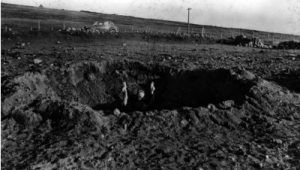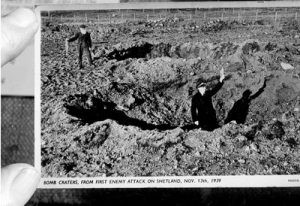“Run Rabbit Run” is a song that might sound like a simple children’s rhyme at first listen. However, this seemingly innocuous tune became a powerful anthem during World War II, deeply embedded in British culture thanks to the comedic duo Flanagan and Allen. Originating from the stage revue The Little Dog Laughed, this song, “Run Rabbit Run,” took on a life far beyond its initial comedic intent, evolving into a symbol of wartime resilience and even finding relevance in contemporary cinema.
From Stage Revue to Wartime Hit: The Origins of “Run Rabbit Run”
The song “Run Rabbit Run” emerged from the creative minds of the British entertainment scene in the 1930s. Bud Flanagan and Chesney Allen, celebrated as Flanagan and Allen, were integral members of The Crazy Gang, a popular British comedy troupe. Within this group, they contributed to stage revues like The Little Dog Laughed, which, typical of The Crazy Gang’s style, incorporated comedic songs and dances to playfully address contemporary issues. It was within this revue that “Run Rabbit Run” first debuted. The music was composed by Noel Gay, a renowned British composer known for his collaborations with The Crazy Gang. The witty and humorous lyrics were penned by Ralph Butler, a songwriter skilled in injecting comedic elements into his work. Even a casual listen to “Run Rabbit Run” song reveals the lighthearted, almost absurd language, which, ironically, would become intertwined with the serious realities of World War II.
“Run Rabbit Run” Lyrics: A Seemingly Simple Rhyme
On the farm, ev’ry Friday
On the farm, it’s rabbit pie day
So ev’ry Friday that ever comes along
I get up early and sing this little songRun rabbit, run rabbit, run, run, run
Run rabbit, run rabbit, run, run, run
Bang, bang, bang, bang goes the farmer’s gun
Run rabbit, run rabbit, run, run, run, runRun rabbit, run rabbit, run, run, run
Don’t give the farmer his fun, fun, fun
He’ll get by without his rabbit pie
So run rabbit, run rabbit, run, run, runRun rabbit, run rabbit, run, run, run
Run rabbit, run rabbit, run, run, run
Bang, bang, bang, bang goes the farmer’s gun
Run rabbit, run rabbit, run, run, run, runRun rabbit, run rabbit, run, run, run
Don’t give the farmer his fun, fun, fun
He’ll get by without his rabbit pie
So run rabbit, run rabbit, run, run, run
At face value, the lyrics of the “Run Rabbit Run” song appear straightforward. They depict a farmer’s hunt for rabbits to make pie, a seemingly innocent rural scene. However, this simplicity belies the song’s deeper resonance and its unexpected transformation into a wartime anthem. To truly grasp the significance of “Run Rabbit Run” for the British during World War II, we need to delve into the historical context that enveloped its rise to popularity.
The Shetland Incident and the Birth of a Wartime Symbol
“Run Rabbit Run” premiered in The Little Dog Laughed on October 11, 1939, shortly after the outbreak of World War II. While its initial intent might have been purely comedic, the song’s cultural impact solidified just a month later. On November 13, 1939, the German Luftwaffe, the aerial warfare branch, targeted British flying boats in Shetland. The bombs missed their intended targets, instead creating a crater in Shetland. Local residents investigating the site reportedly found two dead rabbits. This peculiar incident, though seemingly minor, became a pivotal moment in the “Run Rabbit Run” song‘s journey.
 Photo of rabbits presented as alleged victims of German Luftwaffe bombing in Shetland during WWII, a propaganda stunt.
Photo of rabbits presented as alleged victims of German Luftwaffe bombing in Shetland during WWII, a propaganda stunt.
The Shetland Museum’s archives reveal a more nuanced story behind these “rabbit victims.” According to the museum, the rabbits weren’t actually killed by the German bombs. Instead, they were allegedly placed in the crater as a publicity stunt, having been sourced from a butcher shop in Lerwick. The purpose of this hoax was to portray the German military as incompetent – aiming for military targets but only managing to “kill” rabbits. This narrative, while arguably fabricated, resonated deeply with the British public and significantly boosted the popularity of Flanagan and Allen’s “Run Rabbit Run.” The “dead rabbit hoax” became a symbol of German ineffectiveness, allowing the “Run Rabbit Run” song to be repurposed and parodied as a tool to mock the Germans.
 Vintage postcard depicting rabbits falsely claimed as casualties of a Luftwaffe bombing, used to mock German military failures in WWII.
Vintage postcard depicting rabbits falsely claimed as casualties of a Luftwaffe bombing, used to mock German military failures in WWII.
“Run Adolf Run”: Propaganda and Wartime Morale
Parodies of the “Run Rabbit Run” song quickly emerged as effective propaganda, primarily aimed at ridiculing German leaders, particularly Hitler, and bolstering British morale. The song’s simple, catchy tune made it easily adaptable for propaganda purposes. One incredibly popular parody was titled “Run Adolf Run.” This adaptation replaced “rabbit” with “Adolf,” directly targeting Hitler and portraying him as the fleeing rabbit. The lyrics and accompanying visuals in videos like the one referenced from British Pathé, depicted Hitler’s repeated failures against the British. Lines like “You’re no match altho’ we started scratch[ed]” emphasized British resilience and confidence in eventual victory, despite Germany initiating hostilities. The comedic climax of the “Run Adolf Run” parody often featured Neville Chamberlain chasing Hitler with an umbrella, a humorous representation of British resolve and German vulnerability. This imagery reinforced the propaganda message that the German forces were so outmatched that even everyday British citizens, armed with nothing more than umbrellas, could defeat them. The “Run Rabbit Run” song, through these parodies, became a powerful tool in shaping public perception and fostering a sense of national unity and optimism during wartime.
Lasting Cultural Echoes: “Run Rabbit Run” in Modern Cinema
The cultural impact of “Run Rabbit Run” extends far beyond its wartime popularity. Avid film enthusiasts will recognize the song “Run Rabbit Run” for its recurring presence in contemporary cinema. While some films, like Miss Peregrine’s Home for Peculiar Children (2016), utilize the song to directly evoke the anti-German sentiment of World War II, echoing its historical propaganda usage, other films offer more nuanced and contemporary interpretations.
 Still from the movie *Miss Peregrine's Home for Peculiar Children* (2016), showcasing the film's use of 'Run Rabbit Run' to evoke WWII themes.
Still from the movie *Miss Peregrine's Home for Peculiar Children* (2016), showcasing the film's use of 'Run Rabbit Run' to evoke WWII themes.
A particularly striking example is its use in the critically acclaimed horror film Get Out (2017). In the film’s opening scene, a Black man is abducted in a seemingly ordinary suburban neighborhood while Flanagan and Allen’s rendition of “Run Rabbit Run” plays in the background. This jarring juxtaposition immediately signals to the viewer that the abduction is racially motivated. Get Out cleverly employs the “Run Rabbit Run” song to critique contemporary race relations in America, drawing a parallel to the way British propaganda during WWII utilized racial narratives for political purposes. Just as British propaganda painted Germans as monstrous and inherently evil, Get Out explores how racial biases and prejudices continue to be exploited for social and political control. This unexpected use of the “Run Rabbit Run” song demonstrates its enduring power to evoke complex themes and resonate with audiences across different eras and contexts.
Conclusion: More Than Just a Rabbit Chase
“Run Rabbit Run” is a truly remarkable song. Its seemingly simple lyrics give little indication of the profound cultural significance it attained during World War II and beyond. While originally intended for comedic effect, the “Run Rabbit Run” song became a symbol of British resilience, a tool for wartime propaganda, and, more recently, a vehicle for exploring complex social themes in contemporary art. The song’s unexpected journey from a lighthearted revue number to a multifaceted cultural touchstone underscores the powerful and often unpredictable ways in which music can become intertwined with history and collective identity. The enduring appeal of “Run Rabbit Run” lies in its ability to be both deceptively simple and surprisingly resonant, a testament to the enduring power of song.
Works Cited
“Run Adolf Run,” 1940. British Pathe Archive. https://www.britishpathe.com/video/run-adolf-run
“Luftwaffe Kills A Rabbit, Perhaps,” December 10, 2011. Strange History. http://www.strangehistory.net/2011/12/10/luftwaffe-kills-two-rabbits-perhaps/
Williamson, R. “Bomb Crater.” November, 1939. Shetland Museum Archives, http://photos.shetland-museum.org.uk/index.php?a=ViewItem&i=129694&WINID=1511835425265


